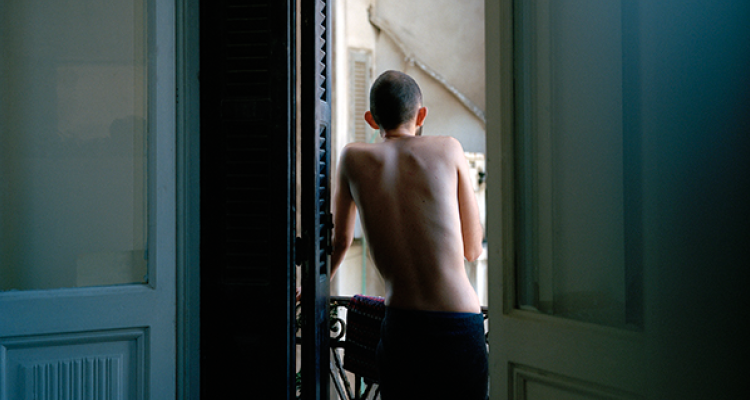 George Awde, Untitled, Cairo, 2013. All images courtesy the artist.
George Awde, Untitled, Cairo, 2013. All images courtesy the artist.
The progression of a day is charted through the passing of time, visually marked by the changing presence of light that feeds cyclical processes of growth and renewal. Sunlight bookends its beginning and end, while moonlight can appear unannounced. Much like the sequential passing of a day, George Awde shoots in serial rhythms, sectioning together moments across days, weeks, and years to write an expanded image-based narrative of existence in times of extreme political and social unrest. But time is not a straight line. It has many iterations and durations, moving backwards and sideways, revisiting histories in order to process something beyond. While Awde’s images are cumulative, chronologically they are not. Instead they are continuously in process without end, morphing into and from each other, much like reality in which we reflect on past and present to project the possibility of the future.
Primarily photographing in Beirut, Cairo, and Syria since the mid-2000s with groups of young men, often laborers from these cities and Syrian Kurdistan, as central protagonists, comrades, and friends, Awde weaves a progressive construction around the image of the body, identity, and context through a striking interrogation of process, light, and form. A background in painting developed a photography practice focused on shooting large and medium format film. Photography marked a commitment to the physicality of object and light as subject, the recording of light through the camera and the physical process of development. Slowness and repetition in these actions are rearticulated as strategies through which a study on the process of time, movement, and change – of luminosity and the physicality of an individual and a place – can unfold.
In this framework, the material surface receiving light dictates levels of absorption. Sunlight imprints the reflection of a window onto a wall on which a small, framed mirror is hung that in turn reflects the window through which the light streams. The skin of a young boy drinks up the sunlight softly lapping on one side of his face, shadowing the other in darkness. The body is smooth, tactile, and warm, radiating the soft glow that captures precise, revered moments of physical intricacy; a back twists, the neck turns, an arm is raised to hold a shoulder. While the presence of intimacy between subject and photographer signifies trust and cohesion, Awde deliberately plays with modes of constructed representation, choreographing an image of desire in the male physical form. The adoption of Polaroid film in the Cairo works from 2014 accelerates and aggravates the aestheticized quality of process and subject to respond more acutely to the immediacy of the disintegrating political and social landscape of the city
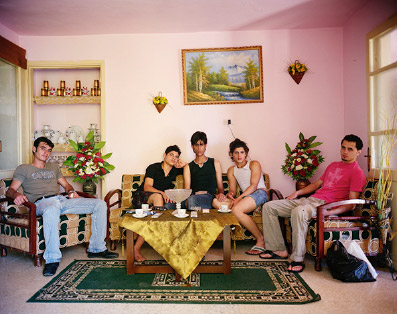
George Awde, Untitled, Beirut, 2007. Inkjet print from 4” x 5” negative
The structure of family, gathering, and kinship are present in portraits of young Lebanese men as Awde begins returning to Beirut from his hometown of Boston in 2003 to rebuild a relationship with the city where much of his family lives. The Calm Before (2006) speaks to a moment of potentiality for a country in motion, halted due to the start of the 2006 Lebanon War. The artist’s return to Beirut during these years also marks a process to seek clarity of self as healing process during his father’s illness over many years and following his passing in 2008. The move from the series Homeland America (2006-7) to Quiet Crossings (2007) charts a shifting interest in ideas around traditions of family and conventions of the unit. The study of exterior and interior aesthetics of the American and Beiruti home and family in these two series identify national and culturally specific systems of belonging and acceptance adapted across geographies and borders.
The 2006 War ruptured this moment, leading to the series Quiet Crossings (2007) in which Awde begins exploring what he describes as “the underbelly of the city.”[i] Responding to a nationalist construction of masculinity and identity in Lebanon during the war, the transitional, public and private spaces outside the state-defined constructs become central to the narrative, of equal importance and in constant dialogue with the body. The camera’s tone is more observational looking from perspectives where it maybe should not. As an object of suspicion during this moment of uncertainty it becomes more discreet. Alternative channels of existence, economy, and living spaces are charted in the underpass of the urban bridge or highway; two figures are captured leaning into a car window, shot across the bonnet of a car on the opposite street, sun streaming through the channel of nowhereness, dancing off glass and metallic surfaces, darting warmth and energy into the otherwise darkened, undefined space. A single body wrapped in a blanket appears to be asleep on top of a concrete plinth next to the River Nile nestled in the armpit of a brutalist column structure on which highways intersect above. The room of an apartment shared by five or six men, who sleep criss-crossing the almost bare floors at angles, some covered in blankets, is shot at night from a window across the street. In these images from 2006, the street is a vessel for transition, anonymous individuals moving through unmarked territory, on their way to somewhere, or perhaps nowhere; a statement on the stagnation of class mobility.

George Awde, Untitled, Cairo, 2013. Inkjet print from 4” x 5” negative
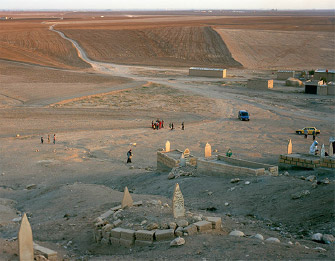
George Awde, Untitled, Qamishli, Syria, 2010. Inkjet print from 4” x 5” negative
These portraits of non-spaces identify the place of potential physical interaction, hidden exchanges of intimacy, pleasure, and potentially danger, to intentionally complicate ideas of male kinship. Moving outside into public space it is the question of “place” that is subject. The physical construct of buildings are abstracted, literal metaphors of protection and shelter. Attention to structural elements of the window and the wall speaks to a reading of the generative formation of space, cities, and nations. Conditioning a form of community and belonging that provides mutual solidarity, support, tenderness, and friendship in times of crisis heightens the importance of solitude and individuality. In these moments the body and architecture are reliant on each other, confrontational of displacement as socio-political systems and structures decompose.
In Quiet Crossings (2007), the lens moves beyond the city to rural Qamishli, Syria, on the border with Iraq and Turkey, marking a more focused study on transiency and displacement. The natural land is read through architectural language, the winding route of the river and the road mark out borders within borders in the white sand steeped in orange light. The quietness of these moments reflect on the Syrian-Lebanese relationship, one born through consistent communication, instability, and border contestation. The graveyard present in one such image provides a literal reference to questions of existence and the metaphorical borders of life beyond this world. The vast desert speaks to blurred lines and struggles of Syrian nationalism and geographical belonging.
As Awde’s previously reappearing Syrian and Lebanese characters depart Lebanon for Syria at the beginning of the civil war in 2011 (in Shifting Grounds (2011), considered to mark the beginning of the Beirut series) a younger group of Syrian characters become central and the aesthetic tendencies of the body transition. The young boys’ changing physicality charts the passage of time at an accelerated rate, their adolescent stances mimicking those of older men and intense stares attempting a maturity and strength beyond their years. The arm, often previously a languid limb, becomes an intentionally placed connective of two or more bodies, placed on a friend’s shoulder, demarcating trust and reliance on each other but also to the interior and exterior walls of the buildings and spaces on which they lean. There is an urgency in their expressions, of the self, the collective, a grasping for a position, a presence.
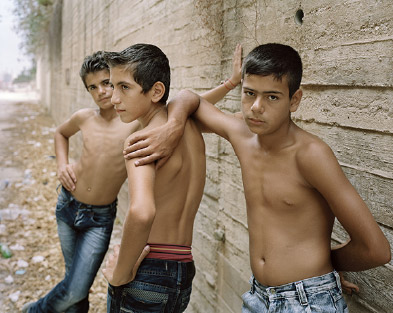
George Awde, Untitled, Beirut, 2012. Inkjet print from 4” x 5” negative
But there is continued sustained cell phone connection with an older group of men as they move through new territories, activated as citizens and fighters. They share social media images with the artist, directly reflecting their contexts at the start of the civil war. These display another construction of the self, in which trophy guns become a prop for self-empowerment. In these images, “the nation versus the rebel,”[ii] as Awde describes them, the camera acts in the similar way to a gun as a form of protection. The masculine, strong body of the fighter reappears, scars adornments of conflict with their countries in turmoil. They also share previously undeveloped 35mm film with Awde taken by themselves from years prior, a marker of their own identity not staged for the artist, in which guns and notion of strength are also clearly present. An image Awde has only shared on his own terms shows his father, a Syrian socialist, dressed in military uniform holding a machine gun. The gun is big, almost crutch-like as he leans against it. His father appears empowered as does his uncle in a similar photograph. A nationalist construct of masculinity is evident, the progression of a ritualized, enforced rite of passage from civilian to fighter. Awde speaks of the extension of this passage in an image in which he tends to his sick father many years later, prior to his death. Awde talks of the machine as a symbol of his father’s changed body and spirit; the machine gun and the machine that supported him in the last months of his life. The transitional process of the body in motion becomes subject, tracing the passing of time and the rites of passage, from boy to man, and man to fighter, fighter to citizen.
The artist’s more recent works, the Cairo series, begins in 2012 at the time of the protests against Mohamed Morsi, then President of Egypt, setting a quieter tone. The aggressively changing political context of Cairo at that time instigates a more immediate and responsive form, marking a shift from large and medium format film to Polaroid. As with the physical object of the photograph in these pictures, form leads content; light falls on the feline arch of a man’s back, shading his skin in washed out stripes at odds with his delicately pronounced spine. The balcony of an apartment is shot at night and in the day; landscape, trees, and nature with organic presence in the muted warm hues of late summer give a feeling of exposure, to the elements, the sun, air, and light. The photograph as architectural form holds an urgency but also a holistic, controlled, and private response to a present state of political transition and instability.
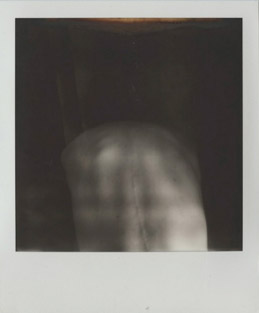
George Awde, Untitled, Cairo, 2015. Polaroid
The physicality and sensuality of the male body returns in form and flesh but with a pending disquiet and contemplation of existence in the Cairo works and His Passing Cover, from 2013 on. The face or body turns looking through windows onto the city. There is a longing for stability to fulfill the search for desire, companionship, physical intimacy, and in this, a sense of place or belonging. The act of repetition and return appears at its most informal here, with the consistency in Awde’s relationships with these men, through friendship and attraction, constituting a place in which to encounter life as it is, rather than a construction of what it could be.
The trajectory or expanse of time as movement forward but also time as a demarcation of change is observed in the form of the ‘line’ – a visual, literal, and metaphorical thread that reappears in George Awde’s work – such as a man’s back or arm, the river, the road, and the national border. Lines of light and shadows draw routes across skin and concrete, leaving tacit eyes lusting. In this trajectory of desires, Awde is witness to movement, change, and progress for the individual and collective over the last ten years, during which the Middle East, and particularly Egypt, Syria and Lebanon have experienced searing social scarring that continues to worsen, significantly so for Syrian nationals as the struggle for place and belonging is met with restraint and disorganization internationally. This challenge, to the individual and multiple person’s ability to implement their own mobilized citizenry, standing for politics and social justice in which they believe rather than imposed through state indoctrination, is inherent throughout these images taken over the last ten years. Tracing struggles for meaning and existence through a commitment to developing and maintaining relationships with subject, place and the shifting conditions of these locations is in itself a political statement on the meaning of uncertainty in being and the activation of self.
About the Artist: George Awde (Boston, 1980) is a visual artist currently based in Doha, Qatar. He has shown internationally including recent solo exhibitions: Fragile States, East Wing. Dubai, 2015; His Passing Cover: 15th FotoFest Biennial, O’Kane Gallery, University of Houston Downtown, 2014; Quiet Crossings: Korn Gallery, Drew University, Madison, 2011. Group exhibitions include: I Spy With My Little Eye, The Mosaic Room, London, 2015; Voies Off des Rencontres, Arles, France, 2015; Shangri La: Imagined Cities, Los Angeles Municipal Art Gallery, Los Angeles, 2014; Unsaid, Unheard, Untitled, Villa Paradiso, Beirut, 2014; Confluence: Photographic based works from the Contemporary Middle East, VCUQatar Gallery, Doha, 2014. He holds an MFA in Photography from Yale University, New Haven, and a BFA in Painting from Massachusetts College of Art, Boston. Awde is Co-Founder/Co-Director of the artist residency marra.tein in Beirut and Assistant Professor in Visual Art at Virginia Commonwealth University, Qatar.
All images courtesy the artist.